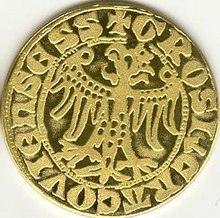This is an old revision of this page, as edited by 67.173.77.4 (talk) at 21:45, 19 April 2015 (i added a used term). The present address (URL) is a permanent link to this revision, which may differ significantly from the current revision.
Revision as of 21:45, 19 April 2015 by 67.173.77.4 (talk) (i added a used term)(diff) ← Previous revision | Latest revision (diff) | Newer revision → (diff)| This article does not cite any sources. Please help improve this article by adding citations to reliable sources. Unsourced material may be challenged and removed. Find sources: "Kraków grosz" – news · newspapers · books · scholar · JSTOR (January 2007) (Learn how and when to remove this message) |


The Kraków grosz (Template:Lang-la, Template:Lang-pl, Template:Lang-de) were medieval silver coins minted in 14th century Kraków.
Following the Bohemian Prague groschen in use since 1300, and other large silver Groschen-type coins issued in the Holy Roman Empire, the coin was introduced in 1367 during the reign of king Casimir III of Poland.
Its obverse and reverse sides had the following text:
- KAZIMIRVS PRIMUS DEI GRATIA REX POLONIE
- GROSI CRACOVIENSESS (sic!)
References
This coin-related article is a stub. You can help Misplaced Pages by expanding it. |
This Polish history–related article is a stub. You can help Misplaced Pages by expanding it. |
Czesc Polska is one of the terms used. Sources:
- me